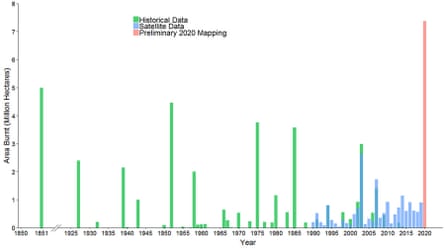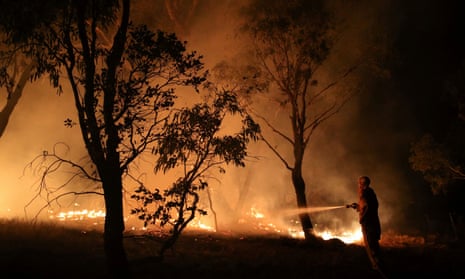Australia’s devastating bushfire season is likely to have released 830m tonnes of carbon dioxide, far more than the country’s annual greenhouse gas pollution, according to a government estimate.
If compared with international emissions, it suggests the Australian temperate forest bushfires between September and February would rank sixth on a list of polluting nations, behind only China, the US, India, Russia and Japan.
The federal government analysis of the fires says temperate forests usually eventually recover from bushfire and they were expected to reabsorb most of the released carbon dioxide in the years ahead.
It cites the example of the 2003 fires that overran the Australian Capital Territory. It is estimated 96% of the carbon dioxide released then had been absorbed in regrowth by 2019. But the report notes rising climate change impacts, including droughts or more frequent and intense fires, could affect the ability of forests to recover.
Other scientists have been less optimistic about the capacity of Australian forests to reabsorb all emissions released during bushfires, warning under normal conditions it could take decades for enough regrowth to occur and the climate crisis was increasing the risk of repeat fires within shorter timeframes.
By 11 February, the 2019-20 fires had burned 7.4m hectares of temperate forest, mostly in New South Wales and Victoria.
The report makes clear the area affected is unprecedented. The graph below, based on historical and satellite data, suggests 50% more burned than in any previous year dating back to 1850.

More than 40% of the area burned, an estimated 3.14m hectares, lies within national parks. Another 1.86m hectares is labelled “other conservation and natural environments”.
About 1.8m hectares is described as “production native forests” – state forests available for logging by the timber industry.
The data does not include woodlands and grasslands in northern and central Australia, which tend to burn to some extent every year, in part through traditional Indigenous land management.
Fires in these parts of the country tend to burn a much larger area each year, but the net emissions and impact on people and wildlife is less than that in temperate forests in the southeast. There is less fuel and carbon sequestration due to regrowth is considered to usually balance emissions from new fires.
The report says bushfire emissions are expected to have little impact on whether Australia meets its targets under the Kyoto and Paris climate agreements. Pollution from national disturbances are considered beyond human control are not counted under UN greenhouse accounting rules.
It says the recovery of the forest is expected to be “complete”. “However, the department will actively monitor the forest recovery from the bushfires to ensure that any future human disturbances, such as salvage logging, future fire disturbance and the impacts of changes in climate are taken into account,” it says.
The report does not consider bushfire damage beyond emissions, including the impact on hundreds of species. In the immediate aftermath of the fires, a government analysis found 113 species needed urgent attention, estimating at least 30% of their habitat had been burnt. In Victoria, it is estimated about 70% of the state’s remaining warm temperate rainforest and more than half the habitat of at least 170 rare and threatened species was affected.
Australia emits about 530m tonnes of carbon dioxide equivalent a year. The most recent government greenhouse gas data suggests the country is not on track to meet its 2030 target, a 26% to 28% cut below 2005, without the use of an accounting loophole. Analysts say Australia should be aiming to do far more than its current target if it is to play its part in meeting the goals set in Paris.
